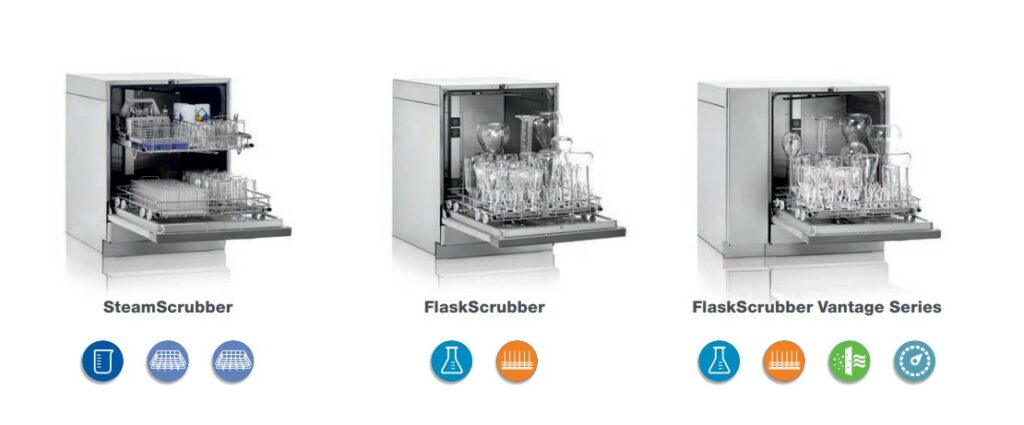Laboratory glassware washers help create efficiencies, while reducing likelihood of contamination using technology. Regulatory, safety guideline requirements, budget and other factors may impact which washers are best fit for your needs.
When choosing a glassware washer, you should account for washing needs, energy efficiency, cleaning process, wash cycle and more.
Your Laboratory Requirements for Glassware Washers
The underlying purpose of glassware washers is to streamline processes, save on manual labor, reduce water usage over time with technology and to have clean glassware.
Lab Usage
Some glassware washers are better suited for a particular lab, compared to an entire department. Additionally, how much will be washed in a given day or week, and what types of glassware is being used?

Facilities with separate service departments for glassware handling and have prep rooms might be looking at stacked solutions. Undercounter and freestanding washers are better for flexible use and more modular or ergonomic placement.
Consider size constraints when looking at glassware washer models and types. Smaller washers and larger chamber washers have different access options. Two door washers will need more space compared to a single hinge door.
As you prepare to purchase a lab-grade dishwasher, pay attention to your lab’s activities and usage.
Utilities
Review available utilities to better understand what type utilities will be needed. Consider exploring how involved it would be to add electrical, hot water cold water and any other system needs. Consider available voltage and energy consumption. Larger labs that expect to use glassware washer heavily can look into 208V if necessary. Codes should also be followed in regards to drainage and electrical.
Materials Used
Materials can have differing cleaning and sterilization requirements. For example, glass and plastic generally have to be treated differently when machine washing. Pyrex, Corex and Vycor each contain different compounds and are made to withstand differing compounds and chemicals.
Boron-Free Glassware
A notable feature of this glassware type is that it requires more careful cooling and heating than others. A lab with a lot of glassware of this type should have a washer that won’t cool or heat harshly.
Flint Glassware
This glassware has a very low heat tolerance. If it’s present in your lab equipment, make sure the glassware washer can dry and wash at lower temperatures.
Machine Features

Drying Capabilities
Lab grade glassware washers have different drying capabilities. Drying needs can vary between types of glassware, such as Erlenmeyer and volumetric flasks.
Flasks used for measuring volume are best dried with a current of warm air. This prevents warping which could seriously hinder accuracy.
Additional consideration should be taken for labs involved in contamination sensitive research. The FlaskScrubber Vantage Labconco glassware washer for example has HEPA filter to remove contaminates during the drying cycle.
Baskets and Inserts

With most models, the basket and insert options will vary. This is something to consider depending on your needs. Narrow-necked beakers require baskets with injector nozzles. Very tall beakers require longer injector nozzles.
Be sure to check that the washer has baskets and inserts suitable for your lab’s popular glassware type.
Programmability

A key feature of any washing machine is automation. This helps reduce personnel involvement and create additional efficiencies. Programmable features allow users to set cycles based on time, temperature, or other factors. These programs can be saved and recalled later. Labconco washers have an easy-to-use touchscreen for programs and review. The CleanWorks OS offers full control of wash parameters and washer settings. This includes:
- Water temperature
- Detergent and rinse aid amounts
- Wash and rinse cycles
- Number of rinses
On the Vantage model, up to 200 user-settings can be stored, and the system ship with 12 factory-preset programs for reproducible protocols. Up to 8 pure water rinses can be programmed. The CleanPoint conductivity monitoring technology measures water quality and skips unneeded pure water rinses. All data is exportable via USB or Ethernet.
Other models may offer fewer options, but ultimately, you can align cycles and programmability with your needs and budget.
Water Purification Level
Some substances will react with those found in non-purified water. Check to see if your lab uses these often. If so, consider purchasing a water purification system with your washer. If this is not an option, you can also make water monitoring abilities a priority. Some models can monitor water quality.
What is Your Budget?
Staying within your lab’s budget is important. However, you shouldn’t limit your spending to a fault. Selecting a washer purely based on price tag could put you in a worse situation. Similarly, opting for the washer with the most bells and whistles can negatively impact bottom line and planning.
In some cases, there may be features you can forgo. For example, a washer with a solid door is usually less expensive than one with a glass viewport.
However, there are situations where the price difference is reflective of performance capability. Stainless steel is needed, for example if the washer will be exposed to harsh chemicals. This may come at a higher cost, but is a necessity. Washing machines that are not rated to laboratory use will likewise cause issues, since they lack injectors and other capabilities. They can also cause cross-contamination between glassware since they use a single pump.
Get a Quote on a Lab Grade Dishwasher

Choosing the right washer for your needs might seem overwhelming. The benefits of using a machine washer over manual cleaning are plentiful. It is important to choose a unit that best fits your needs, fits your space and compliments workflows.
Contact our expert team for insight and guidance on selecting a washer.

